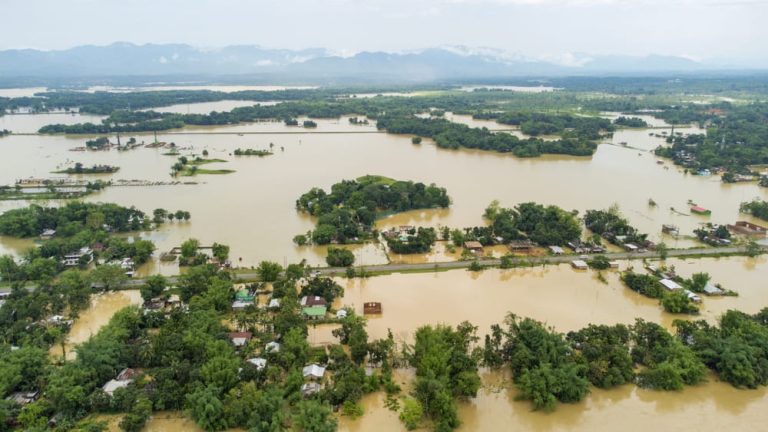Chhirpokhari, a once-thriving village in Dhanusha district, no longer exists. A settlement that was home to nearly a hundred households, supported by agriculture and natural water sources, has now vanished. What was once a prosperous village has become a barren wasteland, leaving behind only two cement-lined wells as a haunting reminder of the past.
In the last week of July 1987, a devastating flood from the Jalad River wiped out the entire village. The river, which had been eroding the land every year, finally submerged the settlement. Today, only a few remnants remain of what was once a vibrant community.
A Flood That Changed Everything
Raj Kishor Yadav was a teenager when the flood struck. He remembers the terror of that day. “It had been raining since morning. The river changed its course, and the land near our homes started to erode. I was newly married, and my younger siblings were small. As the flood swept through, we tried to save whatever we could—wooden beams, bamboo, clothes, and grains. But most of our food supplies were buried in the mud,” he recalled, his voice filled with sorrow.
Yadav, like many others, watched helplessly as their homes were destroyed. The village, once full of life, was gone in a matter of hours. “We lost everything, everything that we worked for,” said Ram Ekbal Mahato, another displaced villager. Mahato explained how people from various communities—hill people, Chamar, Koiri, Yadav—lived together harmoniously, farming side by side. But on that fateful night, the flood took it all.
The Aftermath of the Destruction
Lalit Bahadur Budhathoki, now 70, still visits the barren land where Chhirpokhari once stood. Walking for nearly an hour to reach the site, he recalls the loss that no one could ever forget. “Everything disappeared before our eyes. It was not just me; every family in the village was affected,” he said.
Budhathoki shared that the Jalad River had once flowed straight in the early 1980s. Over time, however, the river started to meander, eroding the land around it. By 1987, it had engulfed the entire village. “The river’s width has expanded from 400 meters to over a kilometer,” he added, pointing to one of the old wells. This well, he said, once stood at the same level as the village, but now it is alone in the middle of a wasteland.
The Chure Destruction: A Larger Environmental Crisis
The destruction of Chhirpokhari is a tragic reminder of the larger environmental crisis that Nepal faces, particularly in the Chure region. The village’s history, dating back over 200 years when Tharu communities first settled in the area, is now seen as an early warning of the consequences of Chure deforestation.
Som Prasad Sharma, President of the Federation of Community Forest Users’ Group in Madhes Province, emphasized that the loss of trees, shrubs, and organic cover in the Chure region has disrupted the natural water absorption processes. “Rainwater no longer seeps into the ground, leading to excessive surface runoff. Sediments like sand, gravel, and stones pile up in rivers, intensifying floods and altering their course,” he explained.
The Continued Crisis in Chure
Despite the warnings, the exploitation of the Chure hills for resources continues. Sharma urged for a more proactive approach to conservation in the region. “The destruction continues, and if left unchecked, it will lead to more villages disappearing,” he warned.
Provincial Assembly Member Ram Ashish Yadav echoed this sentiment. “This is not a political issue; it is a fight for survival. If the Chure is not protected, Madhes will suffer first, and its agrarian economy will collapse,” he said. Yadav called on all levels of government—federal, provincial, and local—to prioritize scientific conservation efforts.
Yadav also urged for stricter laws to curb land encroachment, uncontrolled settlements, and illegal logging in the Chure region. He stressed that current policies that encourage environmental exploitation under the guise of land distribution must be revoked.
The Jalad River’s Changing Course
The Jalad River, which once flowed in a straight line, has changed its course three times over the past three decades. Efforts have been made to build embankments to prevent erosion, but they have failed to provide a lasting solution. Environmental expert Vijay Kumar Singh highlighted the disproportionate impact of deforestation. “Conservation efforts are minimal compared to the scale of destruction. The soil in the Bhabar region can no longer absorb water, leading to increased sand deposits in Madhes’s farmlands,” he said.
Singh warned that unless urgent conservation measures are taken, many other villages could suffer the same fate as Chhirpokhari. The destruction of the Chure region is not just an environmental issue—it is a threat to the survival of communities and the agrarian economy of the entire region.
A Wake-Up Call for Conservation
The loss of Chhirpokhari is a stark reminder of the environmental challenges Nepal faces. It is a wake-up call for the need to prioritize conservation efforts in the Chure region. The destruction of this village, along with the ongoing environmental damage, highlights the urgent need for collective action to protect Nepal’s natural resources.
If immediate steps are not taken, the fate of more villages could mirror that of Chhirpokhari, transforming them into barren wastelands.
For more updates on environmental issues in Nepal, visit Nepal Monitor.


